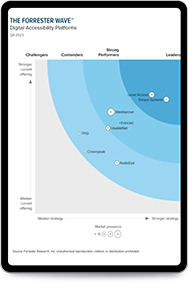United Kingdom Accessibility Requirements
Nov 23, 2020
This post is the second in a seven-part series that provides updates on the current status of accessibility in the European Union and across individual countries in the Union. If you missed it, the first post in the series was European Union Accessibility Requirements. We welcome any comments, thoughts and corrections on the posts with the goal of helping of ensure the best information possible to our partners and customers.
![]()
The Equality Act of 2010 combined several equal access acts and regulations, including the Disability Discrimination Act 1995 (DDA). The disability-related language of the act makes it unlawful to discriminate against people with disabilities in connection with employment, the provision of goods, facilities and services or the disposal or management of premises. Previously the Equality Act of 2006 replaced the Disabled Rights Commission (DRC) with the Equality and Human Rights Commission (EHRC). The EHRC, as the DRC before it, established a body to work to eliminate discrimination against people with disabilities, to promote equal opportunities people with disabilities, to encourage good practice in the treatment of people with disabilities and to advise the government on the working of disability-related legislation.
The Equality Act affects everyone in the United Kingdom that provides services to the public — or a section of the public — whether in the private, public or voluntary sectors. Since websites constitute a service to the public they are covered by Part 3 of the Equality Act. Currently, no reported case law on the application of these Equality Act provisions to web sites exists, however, the act explicitly refers to “access to and use of means of communication … and information services” as examples of services covered by these provisions, and the most recent statutory Code of Practice (BSI 8878) includes commentary and examples that create a very strong anticipation that any future case law will support this interpretation of the act. As such a conservative interpretation of the Equality Act requirements would require that both public and private sector web sites be made accessible.
Recognizing that compliance alone will not ensure a usable site, the British Standards Institution created the BSI 8878 standard. This standard, based on the publicly available “Guide to Good Practice in Commissioning Accessible Websites” (PAS 78:2006), provides guidelines and recommendations on how to create accessible, enjoyable and usable websites for people with disabilities. BSI 8878 was designed to introduce accessibility, universal design and user experience for people with disabilities to non-technical people. It is not a specification that provides specific technical requirements but rather provides guidance and recommendations on process. BSI 8878 includes topics such as using people with disabilities in the life-cycle process and the use of automated tools to assist with testing. The standard discusses how an organization’s choice of technologies can impact the audience as well as guidance for considering the needs of users according to their specific disability—for example, people with physical impairments, sensory impairments or people with cognitive disabilities. Furthermore, it provides text that organizations can use in their accessibility or procurement documents.
The exact set of technical requirements a site should conform to is not defined in either the Equality Act or BSI 8878. Rather the legislation and standards leave it to the discretion of the specific site to determine what accessibility standard to conform to. That said there is a strong recommendation to use WCAG 2.0 A requirements as a minimum set of requirements for a site and broad encouragement to implement the AA requirements and perform user testing on sites.
Subscribe for updates

